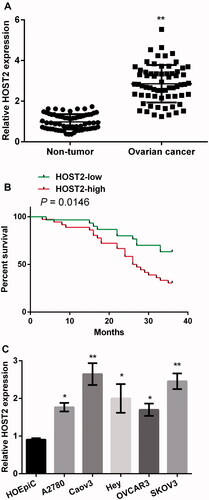Figures & data
Figure 1. The chemical structure of sinomenine hydrochloride (SH). The molecular formula of SH is C19H23NO4-HCl, and the molecular weight of SH is 365.85.
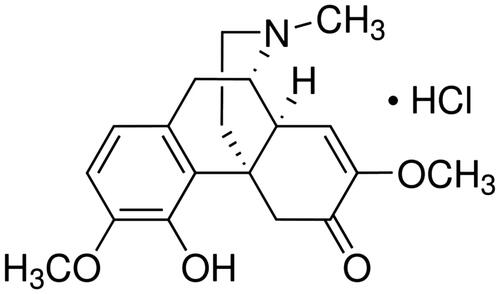
Figure 2. Sinomenine hydrochloride (SH) reserves cell viability and induces cell arrest in G0/G1 phase in Caov3 and SKOV3 cells. HOEpiC, Caov3 and SKOV3 cells were exposed to varied concentrations of SH (0, 2.5, 5, 7.5 and 10 μM/ml) for 24 h. A, SH had no impact on cell viability of HOEpiC cells; B and C, SH administration presented a significant inhibition of cell viability in Caov3 and SKOV3 cells in a dose-dependent manner; D and E, SH statistically raised the cells in G0/G1 phase but dismissed the percentage of cells in S phase in Caov3 and SKOV3 cells; F, SH meaningfully reduced the protein levels of CyclinD1, cyclin-dependent kinase (CDK4) and CDK6 in Caov3 cells; G, representative pictures of cell cycle-related proteins in Caov3 cells; H, SH meaningfully reduced all the protein levels of CyclinD1, CDK4 and CDK6 in SKOV3 cells; I, representative pictures of cell cycle-related proteins in SKOV3 cells. *p < .05, **p < .01, ***p < .001 compared to the corresponding controls
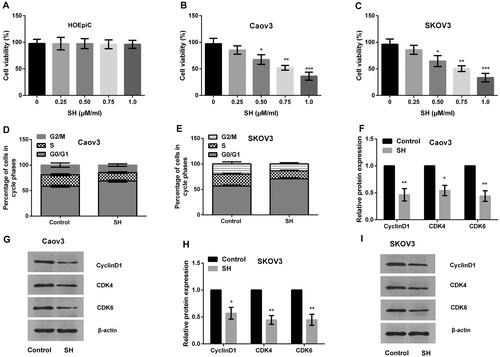
Figure 3. Sinomenine hydrochloride (SH) induces apoptosis in Caov3 and SKOV3 cells. Caov3 and SKOV3 cells were exposed to SH (7.5 μM/ml) for 24 h. A, SH markedly unregulated the percentage of apoptotic rates in Caov3 cells; B, SH obviously diminished the level of Bcl-2, but upraised the levels of Bax and cleaved-caspase 3 in Caov3 cells; C, representative pictures of cell apoptosis-related proteins in Caov3 cells; D, SH decidedly increased the percentage of apoptotic rates in SKOV3 cells; E, SH clearly weakened the level of Bcl-2, but elevated the levels of Bax and cleaved-caspase 3 in SKOV3 cells; F, representative pictures of cell apoptosis-related proteins in SKOV3 cells. **p < .01, ***p < .001 compared to the corresponding controls
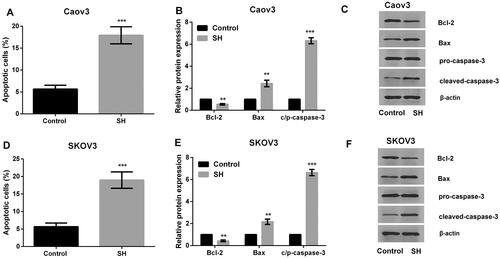
Figure 4. Sinomenine hydrochloride (SH) decreases the expression of human ovarian cancer-specific transcript 2 (HOST2). Caov3 and SKOV3 cells were exposed to varied concentrations of SH (0, 2.5, 5, 7.5 and 10 μM/ml) for 24 h. A, SH administration conspicuously diminished HOST2 expression in Caov3 cells; B, SH administration noticeably weakened HOST2 expression in SKOV3 cells. *p < .05, **p < .01, ***p < .001 compared to the corresponding controls
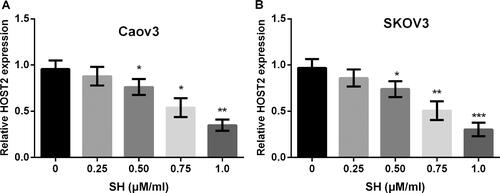
Figure 5. Sinomenine hydrochloride (SH) restrains cell growth, cell cycle arrest and apoptosis via inhibition of human ovarian cancer-specific transcript 2 (HOST2) in SKOV3 cells. SKOV3 cells were transfected with pc-HOST2 for 48 h and/or then were exposed to SH (7.5 μM/ml) for 24 h. A, HOST2 was overexpressed by transfection with pc-HOST2 in SKOV3 cells; B, overexpression of HOST2 statistically reversed the inhibition of cell viability induced by SH; C, overexpression of HOST2 markedly decreased the percentages of cells in G0/G1 phase; D and E, HOST2 overexpression significantly elevated the expression of CyclinD1, cyclin-dependent kinase (CDK4) and CDK6; F, overexpression of HOST2 statistically overturned the promotion of cell apoptosis induced by SH; G and H, overexpression of HOST2 notably elevated the expression of Bcl-2, while markedly decreased the levels of Bax and cleaved-caspase-3. *p < .05, **p < .01, ***p < .001 compared to the corresponding controls
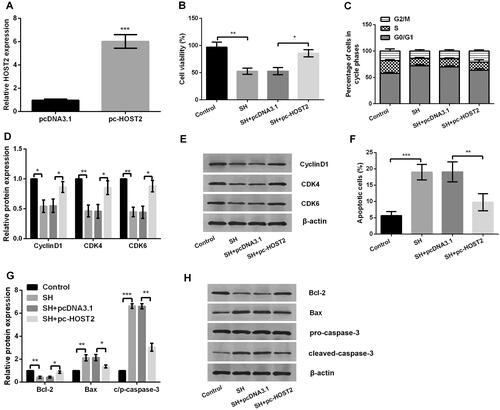
Figure 6. Human ovarian cancer-specific transcript 2 (HOST2) is uregulated in ovarian cancer tissues and cell lines and predicts unfavourable prognosis. The expression of HOST2 was evaluated in 66 ovarian cancer tissues and cell lines. A, HOST2 was highly expressed in ovarian tumour tissues; B, HOST2 was related to the poor prognosis of ovarian cancer individuals; C, HOST2 was significantly enhanced in different ovarian cancer cell lines. *p < .05, **p < .01 compared to the corresponding controls
